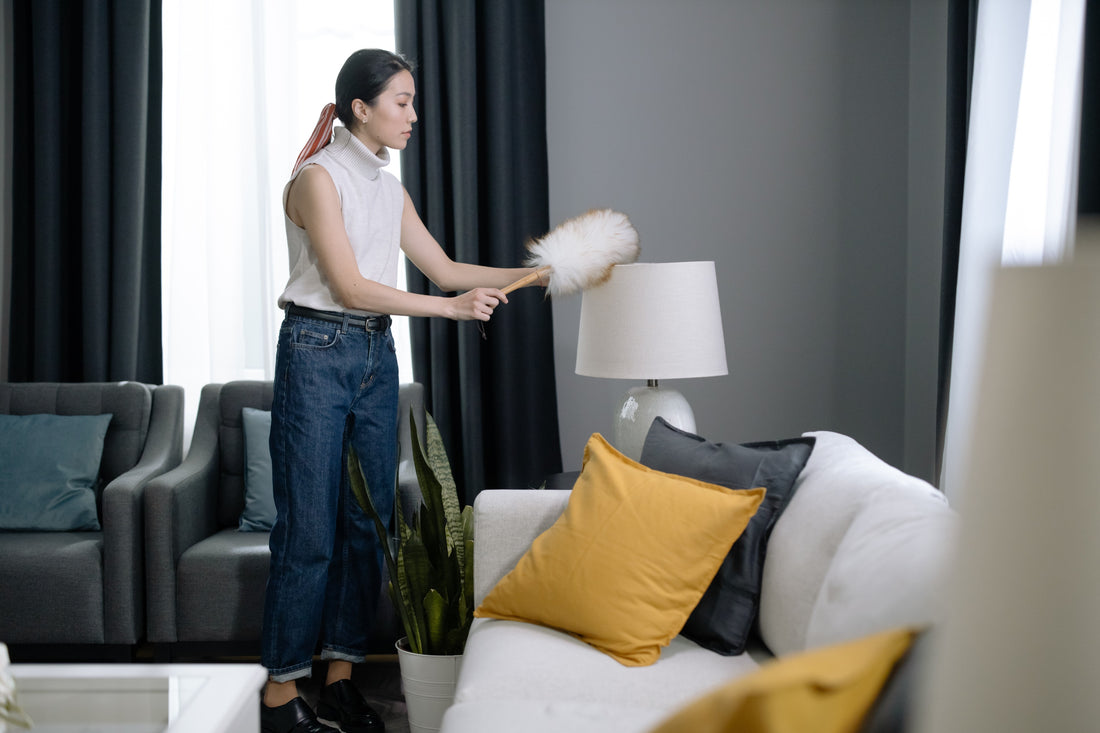
Common Household Eyesores
Share
One of the most common concerns that I hear from home staging clients is that they feel like their homes are cluttered and full of eyesores. In this blog post, I'm going to share with you some of the most common household eyesores and how to deal with them. Most people are not aware of the impact that these small details have on the overall feel of their home. By making a few simple changes, you can dramatically improve the way your home feels and looks.
When it comes to common eyesores, there are effective solutions with minimal work. The following is a list of eyesores and solutions that I've used myself and have personally recommended to clients.
NO-NO TO CLUTTERED COUNTERTOPS
A cluttered countertop or dining area can make even the most organized person feel tense and frazzled. The sight of a messy countertop can be overwhelming, and the thought of having to declutter can be daunting. But don’t worry – you’re not alone! There are many reasons why countertops become cluttered, but there are also many ways to avoid it. By taking some simple steps and making some small changes in your daily routine, you can keep your countertops clear and clutter-free.
TRY THE FOLLOWING TIPS:
1. Reserve counter space for daily necessities only. Create a designated spot for regularly used items.
2. Clean dirty dishes or put them in the dishwasher immediately. Create a morning and/or evening routine to start the dishwasher. We have a system where we load the dishwasher after a dish has been used and in the evening we start the dishwasher. When our daughter comes home from school, she empties it.
3. Don't store all of your appliances on the counters. Keep them out of sight! Create a designated storage space for all of your appliances.
4. Keep a central location for paper and mail. You can create a wall file inside your pantry or allocate a mail drawer in your kitchen. I encourage you to sort through paperwork as it comes in (junk mail goes directly in the recycling bin and bills in one spot), however for busier lifestyles I recommend choosing a specific day during the week to go through paperwork or mail to avoid clutter.
5. Wipe down all countertops and appliances.
6. Sweep the floors and make sure there’s no food or debris left out.
7. Take out the trash and recycle.
8. Put all food away and make sure the fridge and pantry are organized.
By following these simple tips, you can start each day with a clean slate and a clutter-free kitchen!
DO WE HAVE TO SEE THE WIRES?
Whenever possible, opt for wireless devices to reduce the number of wires needed. For example, use wireless speakers, wireless chargers, and Wi-Fi-enabled smart home devices.
Let's try the following tips:
-
Cable Management Solutions: Invest in cable management solutions like cable sleeves, cable raceways, cable boxes or cable clips. These products can help bundle and conceal wires along walls, baseboards, or furniture.
-
Concealing Cords Behind Furniture: Rearrange your furniture strategically to hide wires behind them. Use bookshelves, entertainment centers, or cabinets to mask the cords running from the wall outlets to your devices.
-
In-Wall Wire Concealment: For a more permanent and professional look, consider in-wall wire concealment. This involves cutting small channels in the wall, running the wires through them, and then patching and painting over them for a seamless finish. Ensure you follow proper safety guidelines and consult a professional if needed.
-
Under Carpet Wire Tunnels: If you don't want to drill into your walls, you can use under-carpet wire tunnels or adhesive wire channels that run along the edge of the room and remain hidden by the carpet.
-
Wireless Extension Cords: Use wireless extension cords to extend the reach of your electrical devices without having to run visible wires across the room.
-
Power Strips with Cord Management: Invest in power strips with built-in cord management features that help keep the cords organized and out of sight.
-
Use Furniture with Cable Management: Look for furniture pieces, such as desks or nightstands, that have built-in cable management systems to keep cords neatly tucked away.
-
Zip Ties and Velcro Straps: Use zip ties or Velcro straps to bundle and secure wires together. This helps reduce the mess and makes it easier to hide the cables behind furniture or along baseboards.
-
Create a Charging Station: Designate a specific area as a charging station for your electronic devices. Use a stylish charging station organizer that hides the cables while keeping your gadgets in one convenient spot.
-
Color-Matching: Use cord covers or paintable cable raceways that blend with the color of your walls or baseboards, making them less noticeable.
-
Label the Wires: If you have multiple wires going to the same area (e.g., behind your TV or computer), label the cords at both ends to easily identify them and prevent confusion during setup.
-
Use Cord Hiders: Cord hiders, like cord concealers or cord management boxes, can help hide and organize wires in areas where they are visible, like near desks or media centers.
OVERFLOWING GARBAGE CANS

Overflowing garbage cans in the home can be a significant eyesore and negatively impact the overall aesthetics of the living space. The unsightly view of piled-up waste can evoke feelings of discomfort, displeasure, and uncleanliness, making it difficult to relax or enjoy the surroundings.
To maintain a visually pleasing and welcoming home, it is essential to regularly empty and manage garbage cans, keeping them free from overflow and ensuring a tidy and pleasant living space for everyone.
DUST COVERED SURFACES
Dust-covered surfaces requires a combination of regular cleaning and preventive measures to minimize the accumulation of dust. Here are some effective strategies to keep your surfaces clean and dust-free:
- Dust Regularly: Make dusting a part of your regular cleaning routine. Dust surfaces, such as furniture, shelves, window sills, and electronics, at least once a week or more frequently if needed.

- Use Microfiber Cloths: Microfiber cloths are excellent for dusting, as they attract and trap dust particles effectively. Avoid using feather dusters or dry rags, as they can often spread dust around instead of capturing it.
- Vacuum with HEPA Filters: When vacuuming floors and carpets, use a vacuum cleaner with a HEPA (high-efficiency particulate air) filter. HEPA filters can trap smaller dust particles and prevent them from being released back into the air.
- Mop Hard Floors: Dust and debris can accumulate on hard floors as well. Regularly mop these surfaces using a microfiber mop or a damp mop to pick up dust particles.
- Keep Windows and Doors Closed: When possible, keep windows and doors closed, especially on windy days, to reduce the amount of dust entering your home.
- Use Air Purifiers: Consider using air purifiers with HEPA filters to capture airborne dust particles and improve indoor air quality.
- Wash Bedding and Linens Regularly: Bedding, curtains, and other fabric-based items can collect dust over time. Wash these items regularly to reduce dust buildup.
- Change HVAC Filters: Regularly change the filters in your heating, ventilation, and air conditioning (HVAC) system. This will help capture dust and prevent it from circulating throughout your home.
- Declutter: Minimize the number of decorative items and knick-knacks on surfaces, as these can collect dust. Opt for easy-to-clean, streamlined decorations instead.
- Use Dust-Repellent Products: There are dust-repellent sprays and treatments available that can help repel dust from surfaces for a longer period.
- Check Air Vents: Regularly check and clean air vents and registers to ensure proper airflow and to prevent dust buildup.
- Keep Pets Groomed: Regularly groom your pets to reduce shedding and dander, which can contribute to dust accumulation.
- Address Mold and Mildew: Mold and mildew can attract dust particles. Regularly clean and address any mold or mildew issues in your home.
Piles of Paperwork or Mail
Managing mail and paperwork to prevent it from piling up in your home requires a systematic approach and consistent effort. Here are some practical steps to help you stay organized and keep clutter at bay:
-
Designate a Mail and Paperwork Station: Create a specific area in your home to handle incoming mail and paperwork. It could be a desk, a small table, or even a wall-mounted organizer. Having a designated spot will help you develop a routine for sorting and processing your documents.
-
Sort Mail Daily: Make it a habit to sort through your mail daily. As soon as you bring in the mail, quickly go through it, and separate it into different categories, such as bills, important documents, junk mail, and items that need immediate attention.
-
Shred Unnecessary Documents: Immediately shred any paperwork that contains sensitive information but is no longer needed. This will help prevent identity theft and reduce clutter.
-
Create a Filing System: Set up a filing system for important documents and paperwork that you need to keep. Use labeled folders or file organizers to categorize documents based on their relevance and importance. Keep the system simple and easy to maintain.
-
Digitize When Possible: Consider scanning and digitizing important documents, such as contracts, receipts, or medical records. Store them on your computer or a secure cloud service. This reduces paper clutter and makes it easier to access information when needed.
-
Use a To-Do List: Make a to-do list or use a planner to keep track of pending tasks related to paperwork. This will help you prioritize actions and ensure that bills are paid on time and other important tasks are not overlooked.
-
Set Aside Time for Organizing: Dedicate a specific time each week to organize your paperwork. Use this time to file important documents, discard unneeded papers, and catch up on any pending tasks.
-
Unsubscribe from Unwanted Mail: Take the time to unsubscribe from catalogs, promotional mail, and other unwanted subscriptions. This will reduce the influx of unnecessary paper clutter.
-
Limit Incoming Paper: Whenever possible, opt for electronic statements and online bill pay. Request digital receipts and documents instead of printed ones.
-
Recycle Regularly: Keep a recycling bin in a convenient location, and regularly empty it to dispose of any recyclable paper items.
-
Be Mindful of Mail Handling: Avoid leaving mail scattered around the house. After sorting it, either file it in its designated place, shred it, or take immediate action (e.g., pay bills) to avoid procrastination.
-
Declutter Regularly: Periodically review your files and paperwork to declutter and discard items that are no longer necessary or relevant.
By implementing these strategies and staying consistent with your organization efforts, you can effectively manage mail and paperwork, preventing it from piling up and creating a cluttered home.
YOU MAY ALSO LIKE TO READ:
10 Simple Shortcuts to an Organized Home
Easiest Way to Enhance Your Home



